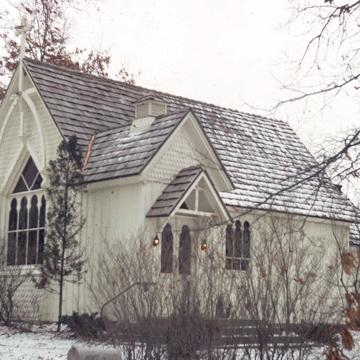This wood-frame, board-and-batten country chapel with four cusped windows and ornamental gable is an excellent example of rural vernacular church architecture in the Gothic style. It was built on his Springbrook Farm for John Harris Forster (1822–1894) and his wife, Martha Mullett. Forster, pioneer surveyor, miner, and engineer, later served in the Michigan Senate. Their large, towered brick house, erected in 1874, stood south of the chapel until 1961, when it was demolished to make way for the A-frame church (1962–1963, Clark R. Ackley). The Forsters selected the site for their home because it was a beautiful spot near the state capitol, just off the Lansing-Detroit Plank Road. John Forster presented the chapel to the Protestant Episcopal Diocese of Michigan in 1888 in memory of his daughter, Kitty (Katherine Fell), who died at age six.
You are here
St. Katherine's Chapel
If SAH Archipedia has been useful to you, please consider supporting it.
SAH Archipedia tells the story of the United States through its buildings, landscapes, and cities. This freely available resource empowers the public with authoritative knowledge that deepens their understanding and appreciation of the built environment. But the Society of Architectural Historians, which created SAH Archipedia with University of Virginia Press, needs your support to maintain the high-caliber research, writing, photography, cartography, editing, design, and programming that make SAH Archipedia a trusted online resource available to all who value the history of place, heritage tourism, and learning.


